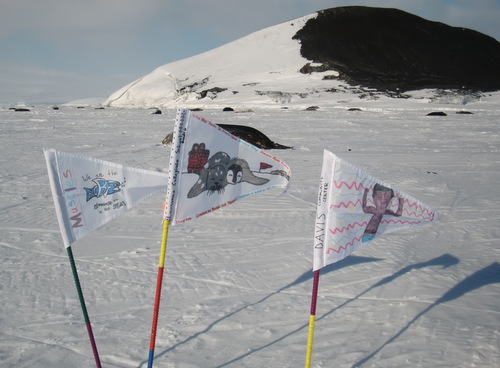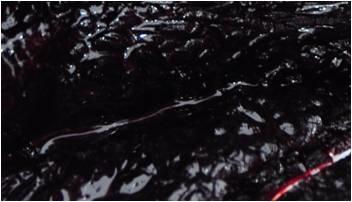
- Bluff City Bluefins Swim Team
- Ms. Catherine Hammons 6th grade (block 6) at Lausanne Collegiate School
- Davis Community Center in Memphis, TN

- Mrs. Caldwell’s 2nd grade class at Crosswind Elementary Students
- The Perkins Family
Crosswind Elementary Students:
- Will Hendrick in Kindergarten
- Miller Utterback in 1st grade
- Bryce Hendry in 3rd grade
- Adithya Suoyaram in 3rd grade
- Lydia Mitchell in 2nd grade
- Emma Kuhn in 3rd grade
- Lily Beagle in 2nd grade
- Elyse Mitchell in kindergarten
- Nick Bertram in 4th grade
Weddell Seal’s Muscle
As this year’s ‘seal season’ is winding down, it seems fitting that one of my last journals is about muscles.
It’s fitting because my muscles are so sore! So here’s a challenge…
Think of all the ways you use your muscles.

What did you come up with?
Here in Antarctica, I use my muscles a LOT. Every day, we walk around with heavy boots, wear about 10 pounds of heavy clothing, load equipment on the truck, put equipment on the snow machines, carry equipment to the seals, unload the equipment, work with a seal, work with another seal, load the equipment back on the snow machines and go back to the lab to process the day’s samples.
Whew! Get the picture?
All of this and more make for a hard day’s work, using my muscles.
But these activities we do intentionally – or on purpose. Did anyone think of the involuntary ways we use our muscles, like blinking, breathing or the beating of your heart?
Voluntary vs. involuntary
We use our muscles intentionally when we work with the seals, but we also use muscles for involuntary activity – the ones our bodies do on their own. You don’t have to think about how to keep your heart beating. You usually don’t notice the tiny muscles in your eyelids that blink every few seconds; and you may not even know that there are muscles in the lining of your stomach and intestines to help digest the food you eat.
How do seals use muscles?
It’s the time of year when the seals spend a good portion of time on the ice, so we haven’t seen them move a whole lot. They’ve been resting and soaking up the sun. But I know, and I’m sure you’ve figured out, that Weddell seals use their muscles all the time. And, just like us, they have involuntary muscles that work behind the scenes to maintain normal body functions. They also have incredible muscles that are specially adapted to what they do best – swim and dive.
Muscles, oxygen, hemoglobin and myoglobin
In order to keep their muscles working when a seal is swimming, it needs energy. A big part of that is getting oxygen to the muscles, so they can do work. But how do seals get oxygen to their muscles when they spend so much of their time underwater? The answer is hemoglobin, the protein in blood that carries oxygen to organs and tissue. We have hemoglobin in our blood, and your doctor may measure how much the next time you go in for a checkup.
Seals also have hemoglobin, and once it carries oxygen to the muscles, it is grabbed by another oxygen-carrying protein in the muscles called myoglobin. Think of it this way: hemoglobin carries oxygen to the muscles through blood. Then, myoglobin grabs the oxygen from the blood and stores it in the muscles, so they can do work, like swimming.
Sounds pretty efficient to me!
Oh me, oh my, oh Myoglobin!
Myoglobin is in the muscles of all animals – yours, mine, fish, chicken, cows and the Weddell seals. You can actually tell how much myoglobin is in a muscle just by looking. Myoglobin has pigment or color, and the more myoglobin present, the redder or darker the muscle appears.
Let’s take a look!

The amount of myoglobin in an animal’s muscle is directly related to how much it uses its muscles. This makes sense because the more a muscle is used, the more oxygen it needs. Right?
Fish like flounder have extremely low levels of myoglobin in their muscle, making the fish filet appear white.
Chicken has both white meat (breast and wing) and dark meat (leg and thigh). Why do you think that is? Chickens stand and roam, using their thigh and leg muscles. Since those muscles are used more, they require more oxygen, therefore, their myoglobin levels are higher and the meat appears darker. Chickens rarely use their breast and wing, since they don’t fly much. So, these muscles have less myoglobin and appear lighter in color or ‘white.’
Cattle are very large and stand most of the time, so their muscles need to work hard. Look at the muscle of the cow above. The juicy steak has high levels of myoglobin. How can you tell? Just look at how red the steak is!
But what about the Weddell seal? Do you think the seal has high or low levels of myoglobin? Will the seal’s muscles appear darker than the steak?
If you said darker, you are correct. The Weddell seal’s muscle has so much myoglobin that its muscle looks almost black. It has about 10 times more than a cow!
That’s a lot of myoglobin!
Their muscle color is off the chart!

Check out this interactive muscle chart!
Why so much myoglobin?
Its purpose is to store oxygen, which muscles use when they are working. The more myoglobin an animal has in its muscle cells, the longer that animal can do work, like swimming or holding its breath under water. Weddell seals, whales and other swimming and deep-diving marine mammals have very high levels of myoglobin. So, the oxygen stored in the muscles is very useful for seals when they go on deep dives foraging, or looking for food.
Oxygen efficiency
These seals are exceptionally efficient about oxygen. Their bodies have:
- Organs and tissue that must have oxygen, like the brain and nervous system.
- Organs and tissue that prefer to have oxygen, like muscles.
If the first group does not get the needed oxygen, the entire body will shut down, but if the second group does not get oxygen, there is a backup plan. Here’s where the seal muscles become very efficient.
Myoglobin in the muscles really likes oxygen – much more than hemoglobin likes oxygen. So, if the seal is working hard and using oxygen – swimming, diving and hunting for food – the seal’s muscles would take all the oxygen. Do you see a problem here? If the seal is working really hard and the blood is flowing to the muscles, the myoglobin in the muscles would keep all the oxygen. That’s not a good thing for an organ like the brain. But don’t worry! It’s not a problem for an animal as efficient as a Weddell seal!
When these seals go on really, really long dives, they have the ability to adjust their blood flow, keeping blood flowing to the more vital organs and tissues, such as the brain. It’s like the seal is saying, ‘Hey muscles, handle this on your own. Generate your own power using the oxygen you have stored in your muscles. We’re not going to give you any more. Blood’s not going to flow to the muscles for a while.’
This usually happens if a dive lasts longer than 20 minutes.
The solution: They typically dive for less than 20 minutes at a time, which means they only have to come up for a few breaths before they can go back underwater.
That’s quite an amazing and efficient animal!


Comments